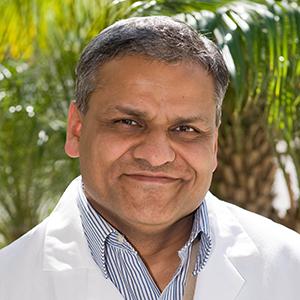It’s that spongy white material beneath the rind of an orange. Most people simply throw it away. But one research team at City of Hope is evaluating a compound found in albedo for its cancer-fighting potency.
Sharad Singhal, Ph.D., research professor in the Department of Medical Oncology and Therapeutics Research, leads investigations focusing on 2’-hydroxyflavanone (2HF), a small molecule that is abundant in the pith of citrus fruit. 2HF is a flavonoid, one among a diverse class of chemicals naturally occurring in nearly all fruits and vegetables.
In a series of recently published laboratory studies, Singhal has uncovered evidence that the pith-y antioxidant may be the basis of a new weapon against breast cancer. Better still, 2HF seems to be safe.
“It worked out very nicely, with no toxicity,” Singhal said.
A Promising Direction
Singhal began investigating 2HF in 2012 and built up results showing its effectiveness against kidney cancer. His early work led in 2016 to a grant from the Department of Defense to study the compound in breast cancer.
That funding has pushed forward his research, with a spate of recent journal articles profiling different aspects of 2HF’s action.
A 2018 study in Oncotarget showed that 2HF hastened the demise of breast cancer cells. It was even more effective in tandem with a drug that blocks both the expression and function of RLIP, a protein that helps tumors form and resist treatment — another topic of interest for Singhal’s lab. Computer models indicated that 2HF inhibits RLIP and other proteins linked to breast cancer, including estrogen and HER2.
Singhal and his colleagues tested 2HF alone against three types of breast cancer, including the particularly aggressive and treatment-resistant triple-negative breast cancer. Their results, published in a 2019 edition of the Journal of Proteomics, demonstrated that while 2HF left a control group of normal breast cells unchanged, in the malignant cells, it reduced the amount of several proteins that are overexpressed in cancer.
Another 2019 laboratory study, appearing in Cancer Letters, examined 2HF and the spread of triple-negative breast cancer. In laboratory models of metastasis to the brain and lungs — common locations where malignant breast cells migrate — Singhal and his teammates found that the compound hindered the disease from moving into those organs.
Most recently, a 2019 Molecular Carcinogenesis paper showed that a combination of 2HF with a pair of drugs that inhibit RLIP prevented tumors in a laboratory model in environmentally triggered breast cancer.
The Road Ahead
Singhal has set a couple of goals before 2HF can move into human clinical trials.
He wants to complete a lab study of 2HF’s ability to prevent breast cancer from appearing spontaneously. He and his colleagues also are taking on an obstacle: 2HF is not water-soluble. This means that, on its own, it is not easily absorbed by the body.
Because 2HF is fat-soluble, in his lab studies Singhal administers the compound along with corn oil. However, in humans, the requisite amount of oil would carry its own health detriments. So Singhal and his teammates are looking to alter the 2HF molecule in a way that will make it water-soluble — without taking away any of its efficacy.
In this project, he is confident in his City of Hope partners (and co-authors of those recent studies), Ravi Salgia, M.D., Ph.D., the Arthur & Rosalie Kaplan Endowed Chair in Medical Oncology, and David Horne, Ph.D., the Dr. & Mrs. Allen Y. Chao Chair in Developmental Cancer Therapeutics.
“We will solve the solubility problem,” Singhal said. “We have Dr. Salgia as a medical oncologist and Dr. Horne as a medicinal chemist, and they know how to deal with these things.”
Singhal is excited about the future of his research into 2HF. In the meantime, he’s identified a new way to eat an orange: pith and all.
“I tell everybody, only peel the darkest skin, then eat the whole thing,” he said. “Don’t throw away any portion.”
****
